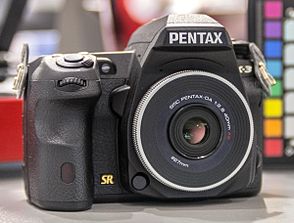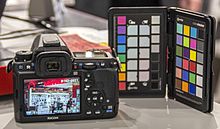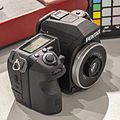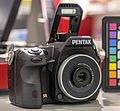Pentax K-3
|
|
|

|
|
| Type: | digital autofocus / AE reflex camera |
| Lens : | all lenses with K-bayonet |
| Lens connection : | K bayonet |
| Image sensor : | CMOS |
| Sensor size: |
APS-C (23.5 mm × 15.6 mm) |
| Resolution : | 23.35 megapixels effective |
| Image size: | 6016 × 4000 pixels |
| Format factor : | 1.53 |
| Aspect ratio : | 3: 2 |
| File formats : | JPEG , Raw (DNG, PEF) |
| Exposure index : | 100-51,200 |
| Viewfinder : | Permanently installed pentaprism viewfinder |
| Field of view : | 100% |
| Enlargement: | 95% |
| Viewfinder display: | AF data, exposure data, image stabilization functionality, spirit level |
| Screen : | TFT color monitor |
| Size: | 8.192 cm (3.2 ") |
| Resolution: | 720 × 480 pixels |
| Operating modes: | P, Sv, Tv, Av, TAv, M, B, X, User 1-3, Video |
| Frame rate : | Max. 8.3 frames per second |
| Number of continuous exposures: | 23 Raw, 60 JPEG (8.3 / s), 32 Raw, 100 JPEG (4.5 / s), 52 Raw, 200 JPEG (3.0 / s) |
| Auto focus (AF) : | Phase comparison , contrast autofocus , catch-in-focus |
| AF points: | 27 |
| AF measuring range: | 25 cross-type sensors, 2 vertical ones, EV −3 to +18, the 3 middle vertical ones for light intensity 1: 2.8 |
| AF modes: | AF.S, AF.C |
| Exposure metering : | 86,000 pixel RGB sensor TTL open aperture measurement with spot measurement / center-weighted measurement and multiple segment measurement |
| Measuring range: | EV -3 to +20 |
| Regulation: | automatically or manually |
| Correction : | ± 5 EV in ⅓ or ½ steps |
| Closure : | electronically controlled focal plane shutter |
| Shutter speed : | 1 / 8000-30 s and Bulb |
| Lightning : | can be folded out manually |
| Guide number : | 13 at ISO 100 |
| Flash control: | P-TTL |
| Lightning connection : | Standard ISO shoe and flash socket |
| Synchronization : | 1st or 2nd shutter curtain |
| Exposure compensation : | manual: ± 3 steps in ⅓ steps |
| Flash functions: | Red-eye pre-flash, long-term sync, long-term sync + anti-red-eye, wireless mode |
| Color space : | sRGB , Adobe RGB |
| White balance : | automatic, automatic multi-field comparison, presets, manual, color temperature |
| Storage media : | 2 × SDHC , SDXC |
| Data interface : | USB 3.0 |
| Video interface: | HDMI (Type C, Mini) |
| Power supply: | Li-Ion battery D-LI90, power pack D-AC132E, battery handle D-BG5 |
| Casing: | Steel chassis, magnesium alloy and plastic |
| Dimensions: | 131.5 mm × 100 mm × 77.5 mm |
| Weight: | approx. 715 g (body only) |
| Additions: | Image stabilizer in the camera for all lenses, level in 2 axes, moire filter on sensor motion, GPS by optional module O-GPS1 for Astro-tracing to 300 s, remote control via USB or additional WiFi card Pentax Flucard PRO 16 GB Class 10 |
The Pentax K-3 is a digital SLR camera that is sold by the Japanese manufacturer Ricoh under the Pentax brand . It was presented on October 8, 2013 as the new top model in the product range. The central component is a CMOS sensor developed by Sony , in which the A / D converters for signal conversion are located directly on the chip. It offers an effective resolution of 23.35 megapixels on 366 mm² and a maximum image size of 6016 × 4000 pixels . In 2014 the camera won the TIPA Photo & Imaging Award in the Best DSLR Expert category .
important characteristics
The sensor format 23.5 mm × 15.6 mm ( APS-C ) corresponds to a format factor of around 1.535 compared to the 35mm format.
For the image stabilization system Shake Reduction (SR), the manufacturer specifies an effectiveness of up to 4 EV . The 3D image stabilizer is built into the housing and can correct camera shake in all 3 axes and rotations by moving the sensor. It works with all lenses, with older or adapted lenses the focal length used may have to be selected manually in the menu. This image stabilizer system offers two further functionalities.
One suppresses the moiré effect , since an anti-aliasing filter was not used to increase the resolution . For this purpose, the SR system can be moved in two stages during exposure in order to suppress the aliasing caused by motion blur in the sub-pixel area. The movement frequency for this is 500 Hz and works reliably up to shutter speeds of 1/1000 of a second, but also improves the image up to 1 / 8000s. This is the first switchable anti-moiré system.
The second function is a tilt-shift function , with which it is possible to move the sensor in 24 steps by ± 1.5 mm horizontally and vertically and to tilt the sensor in 8 steps by ± 1 °. This achieves an adjustment of the image section. Furthermore, the astrotracer function is implemented via this mechanism, so that with very long exposure times the stars are not shown as arcs, but as points.
Power is supplied by a rechargeable lithium-ion battery of the type D-LI90. In an attached battery grip D-BG5 the supply from the battery can handle either with another lithium ion battery or six NiMH batteries of Type AA effected.
The housing is sealed against splash water, moisture, sand and dust with 92 seals.
The weight without battery and memory card is 715 g, and 795 g ready for use. The dimensions of the camera are 131.5 mm × 100 mm × 77.5 mm (W × H × D). A battery handle available as an accessory is also protected against dust and splash water. According to the manufacturer, the camera can be designed for continuous operation in a temperature range of −10 ° C to +40 ° C.
In video mode, the resolutions Full HD (1920 × 1080, 60i / 50i / 30p / 25p / 24p), 4K and HD (1280 × 720, 60p / 50p / 30p / 25p / 24p) are available; the data formats are H.264 / MPEG-4 AVC ( MOV ) for videos or Motion JPEG ( AVI ) for interval film recordings in 4K. The exposure and the tone can be controlled manually. A connection for a stereo microphone and a headphone output are available.
Copyright information and the name of the photographer can be embedded directly into the Exif data of the images by the camera .
The camera has an integrated HDR mode , which can also be used to record hands-free HDR recordings. The camera takes three pictures with -3, 0, +3 EV and aligns the pictures automatically. The strength of the effect can be selected automatically and in four levels. The result can also be saved in raw format .
A two-axis electronic spirit level is built in to help align the camera. It can also be used to automatically align the images when they are captured by the movably mounted image sensor.
With all lenses of the Pentax series DA (except fisheye 10–17 mm ), DA *, DAL, D-FA, the Samsung D-Xenon and D-Xenogon of the same construction as well as three FA-Limited lenses (31 mm 1.8 , 43 mm 1.9 and 77 mm 1.8), the distortion and lateral chromatic aberration ( lateral chromatic aberration ) can be corrected by the camera when taking the picture. If this function is activated, the computing time required for saving is extended.
Bayonet and lenses
The K AF2 bayonet is backwards compatible with all K bayonet lenses that have been built since 1975. Contacts for controlling lenses with focusing by ultrasonic motor are available. In addition, the K-3 has an autofocus motor inside the housing, which drives Pentax AF lenses without their own motor. The dimming option is used for the depth of field preview. For the digital image preview, a test picture is displayed on the monitor and can be saved.
technical description
The exposure index can be set automatically and manually from ISO 100 to ISO 51,200, the intermediate values can be set in half or third increments. The shutter speeds can be set from 1/8000 to 30 seconds, plus there is long exposure (B) and flash sync speed (X) 1/180 second. The images can be saved in the three formats JPG (three quality levels), PEF (Pentax's own raw format ) and the manufacturer-independent DNG format . Images are saved in raw formats with 14 bit resolution. The strength of the noise reduction can be set individually for each ISO value.
The exposure is measured with an RGB sensor with 86,000 pixels, which can be evaluated as a matrix, center-weighted or spot-oriented. Corrections can be made in ⅓ steps in the range of ± 5 EV.
The glass pentaprism viewfinder has a magnification of 0.95 times, a 100% field of view and exchangeable focusing screens, thanks to new coatings it has also become brighter compared to previous models.
The LC display has a size of 3.2 inches, a resolution of 1.013 megapixels and a viewing angle of up to 170 °. The monitor can be used to view in live view mode and, in addition to normal phase AF, to focus with contrast autofocus - optionally with or without face recognition; The depth of field can be assessed in both modes . The monitor can be calibrated in 49 steps.
The A / D converter works with 14 bit color depth. There is a fine correction of the white balance presets as well as several memory locations for manual white balance. An automatic multi-field adjustment has been added, so mixed light situations can be corrected better. Three user programs are used to save and quickly call up a user-specific camera configuration.
Exposure series with three or five images are possible, with different parameters being varied: exposure time, white balance, saturation, contrast and sharpness. You can also do multiple exposures. The captured images can be edited using nine filters.
The maximum burst speed is 8.3 images / second (Hi) , 5 (Mid) or 3 images / second (Lo) . In Hi mode, up to 60 pictures as JPEG and 23 pictures in raw format can be recorded continuously at maximum speed; then the camera records at a reduced speed (depending on the maximum continuous write speed of the memory card).
The 27-point phase detection autofocus system (SAFOX XI) is equipped with 25 cross sensors , the remaining two are linear sensors. The middle three, which are arranged vertically one above the other, are designed for high-light optics with an aperture from 1: 2.8 and thus enable better focusing. Different modes can be selected; this includes Auto-25, Auto-9, Auto-5, free choice of a sensor and central point. In the Auto-9 or Auto-5 mode, the position of this field within the 5 × 5 matrix can be freely selected. The following focusing options are also available: Contrast AF, object tracking, face recognition, manual focusing both via the optical viewfinder and via the LC display .
With the AF fine adjustment, front or back focus problems of individual lenses can be corrected.
Three focus modes are possible: AF-S (one-time autofocus), AF-C (continuous autofocus) and manual. Different combinations of the sensors can be selected for the autofocus. In very low light, the camera can switch on a green LED auxiliary light to focus .
In addition to the contrast autofocus, a focus peaking function is implemented in live view; this shows the points of maximum edge contrast on the display and thus helps to put the sharpness in the right place in the image when focusing manually.
An external flash can be controlled wirelessly using the built-in flash. There is still an X synchronous contact for flash systems. Flash can also be used on the second shutter curtain (with the internal flash and with certain system flash units).
There is an interval control for both the photo and the video area. In the photo area, the intervals between one second and 24 hours can be selected for up to 2000 recordings. In the video area, the intervals from two seconds to one hour can be pre-selected; the maximum recording time is 55 hours.
Web links
Individual evidence
- ↑ PENTAX K-3 wins TIPA AWARD in the "Best DSLR Expert" category at the TIPA Photo & Imaging Awards Ricoh News April 22, 2014
- ↑ TIPA Best Digital SLR Expert: Pentax K-3 ( Memento of the original from May 26, 2014 in the Internet Archive ) Info: The archive link was inserted automatically and has not yet been checked. Please check the original and archive link according to the instructions and then remove this notice.
- ↑ PENTAX K-3 AA filter simulator , YouTube





